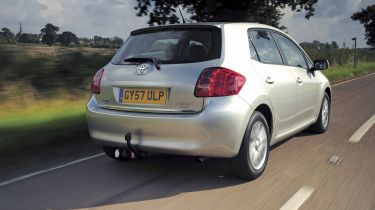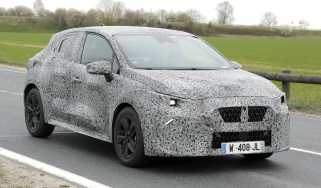Toyota Auris 2.0 D-4D TR
Five-door hatchback is a no-nonsense family runabout
When did you last get excited about a Toyota? While you can’t fault the quality of the firm’s engineering and its commitment to green technology, since the demise of the Celica, Supra and MR2 sports cars, the firm has failed to set pulses racing.
To combat the dreaded ‘boring’ tag, most manufacturers develop sporting flagships for their model ranges. Whether badged GTI, VXR or RS, they sell in small numbers, but show just what’s possible when engineers let their hair down.
Not so with the Auris. The range-topping model is the diesel SR180. Costing £18,695 in five-door form, the flagship can’t match the thrills of similarly priced hot hatch rivals. You’ve got to look further down the compact family hatchback’s line-up to find a model that makes more sense.
Toyota has added the TR variant to provide a taste of sporty motoring at a price to compete with so-called budget rivals such as the Pro_cee’d. So how does it compete? The first thing that’s clear is that the Japanese model is not nearly as racy as its rival. While the TR models pictured in Toyota’s current ad campaign ride on sporty optional alloys, in standard five-door trim – complete with our test car’s tow bar – the Auris looks positively pensionable.
Used - available now

2020 Ford
Kuga
5,063 milesAutomaticPetrol2.5L
Cash £23,100
2023 Ford
Kuga
25,720 milesAutomaticPetrol2.5L
Cash £21,700
2021 Skoda
Kodiaq
44,692 milesAutomaticPetrol2.0L
Cash £23,200
2023 Kia
Rio
24,181 milesManualPetrol1.2L
Cash £10,800Inside, Toyota’s unparalleled car building experience is more obvious. There’s a lack of style, but the Auris is hard to fault ergonomically. The classy floating dials and digital displays look smart, while the upright MPV-style driving position makes the light controls easy to reach.
If you need to travel in the rear, it’s the Toyota you’ll choose. The five-door body gives the Auris a clear advantage for versatility, while its less coupé-like tailgate and simple folding rear seats make its luggage area more practical, too.
So the Toyota loses out in the fashion parade but makes up for it inside – how does it fare out on the road, though? Start the 128bhp 2.0-litre diesel, and refinement is immediately impressive. As you slot the light, accurate gearlever into the next ratio, the powerplant only becomes raucous at high revs. However, performance isn’t as gutsy as the Kia’s; be prepared to make a downchange to keep pace on steep slopes.
Tackle a roundabout or tight corner, and the Toyota turns in without any drama. The steering is a little over-assisted, but if you carry too much speed you will only have to deal with safe, predictable understeer. A smooth ride also comes as standard, helping to make the Auris a great motorway cruiser. Add an 18 per cent company car tax rating and near 50mpg economy, and high-mileage business drivers could do far worse.
The trouble is, there’s nothing at all memorable about the Toyota’s dynamics, styling or cabin. Priced at £15,795 in five-door form or £500 less as a three-door, the TR is a thoroughly sensible option, but these days that’s not enough to be a class leader. Will that cost it victory here?
Details
Price: £15,795
Model tested: Toyota Auris 2.0 D-4D TR
Chart position: 2
WHY: The TR adds a sporty edge to the Auris’s reputation as a reliable family hatch.
Economy
People choosing a Toyota are buying into a long-standing reputation for hassle-free motoring. If the Auris lives up to the reliability standards set by the Corolla, the Toyota should have many years of reliable motoring ahead. As a company car, the Auris makes more sense. Lower rate taxpayers face a bill of £600 for 12 months – around £30 less than the Kia. The 2.0-litre diesel is also superbly economical. After a motorway run, we managed 53.7mpg on one tank. The average of 48.7mpg included our time on a private track when conducting our performance tests. The Auris is also cheaper to insure, sitting in group 18, five lower than the Kia.
Environment
The Auris emits 144g/km of CO2, 5g/km fewer than the Kia. That means it’s one group lower for company car tax. It proved economical in our test, too, returning an impressive 48.7mpg average.







